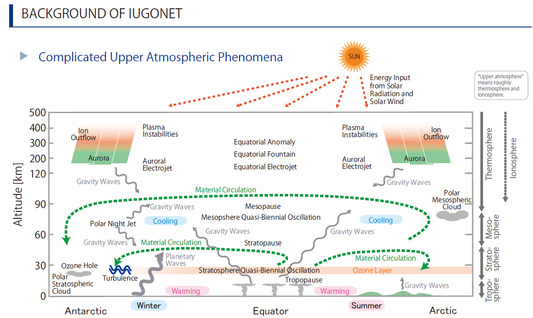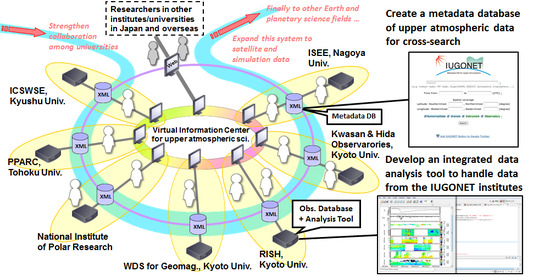Presenter: Atsuki Shinbori (Mission Researcher, RISH Kyoto University)
Title: A study of long-term variation in the upper atmosphere using the IUGONET data analysis system
Place: HW525 (Research Building No. 1)
Associated mission: Mission 1 (Assessment and Remediation of the Humanosphere)
Summary
The Earth’s atmosphere is divided into four region: the troposphere (~12 km), stratosphere (12–50 km), mesosphere (50–90 km), and thermosphere (90–1000 km) according to the height profile of temperature. Moreover, the ionosphere (80–2000 km) is formed in the same height range as that of the thermosphere. Various kinds of natural phenomena observed in the Earth’s atmosphere such as aurora, air grow, and atmospheric waves is driven by a large amount of solar energy (solar radiation and solar wind) emitted from the Sun.

Fig. 1. Various kinds of natural phenomena observed in the Earth’s atmosphere (~500 km) and location of each atmospheric layer. The horizontal and vertical axes are geographical latitude and height [IUGONET pamphlet].
Since the solar radiative energy becomes maximum on the equator and minimum in the polar region, cumulus convection phenomena are activated in the equatorial lower atmosphere. Atmospheric waves originating from the atmospheric turbulences transport momentum into the upper atmosphere, and determine the atmospheric general circulation and temperature structure in the mesosphere and lower thermosphere (60–150 km) due to dynamic effects. On the other hand, the down flow of electromagnetic energy and high energetic particles produced by the interaction between solar wind and magnetosphere concentrates on the upper atmosphere in the polar region. Thus, the solar energy penetrating to the Earth’s atmosphere propagates in the magnetosphere, ionosphere and atmosphere, changing the form, and generates different types of physical phenomena. Since each atmospheric layer globally and strongly couples each other, we need to investigate the transportation of matter and momentum between these atmospheric layers in order to understand generation mechanisms of atmospheric disturbances observed in these regions. Therefore, it is essential to conduct an integrated analysis of interdisciplinary observation data obtained from global ground observation network in order to clarify the long-term variation in the upper atmosphere such as solar activity and global warming.

Fig. 2. Schematic view of the IUGONET project. In this project, we established a metadata database of upper atmospheric data for cross-search and developed an analysis software to visualize and analyze the upper atmospheric observation data [Hayashi et al., 2013].
Under such a background, the Inter-university Upper atmosphere Global Observation NETwork (IUGONET) initiated in 2009 created a metadata data (data catalog) from solar-terrestrial ground observation data accumulated by the IUGONET institutes for a long time, and established a metadata exchange system sharing the metadata on the Internet (Figure 2). Moreover, a data analysis software to handle various kinds of solar-terrestrial observation data is developed.
In this seminar, I will briefly introduce an overview of the IUGONET project and explain how to use the IUGONET products (metadata database and analysis software).
Go to Japanese page
PDF file (336 442 bytes) | Top
20 June, 2016.


